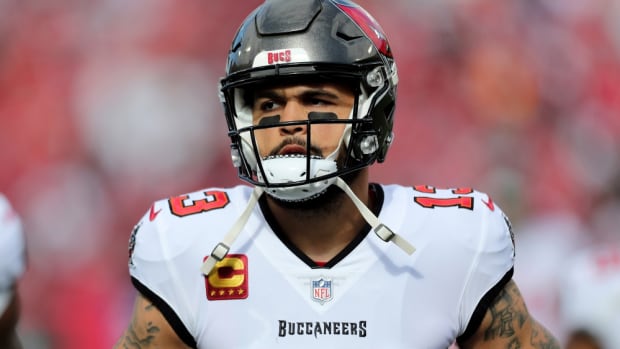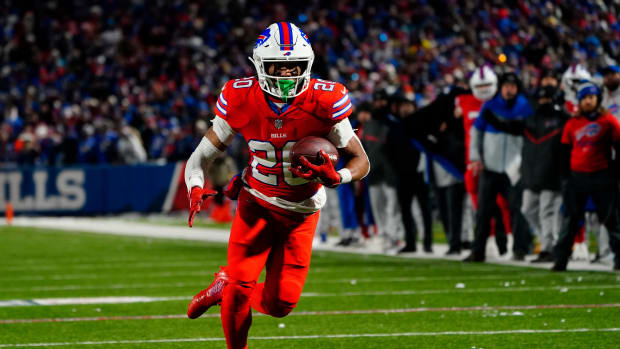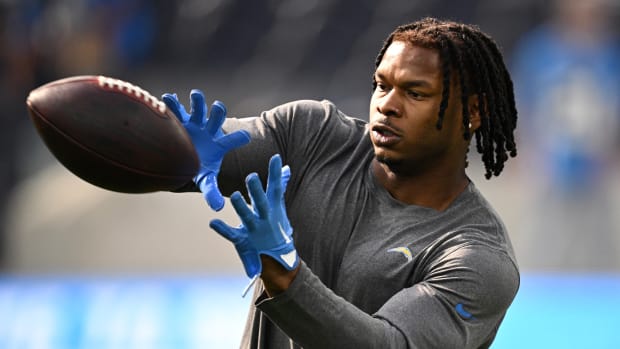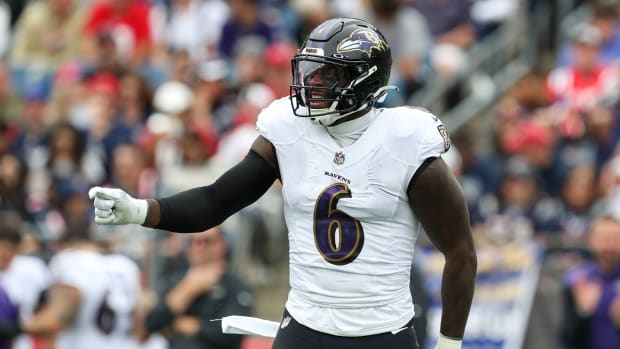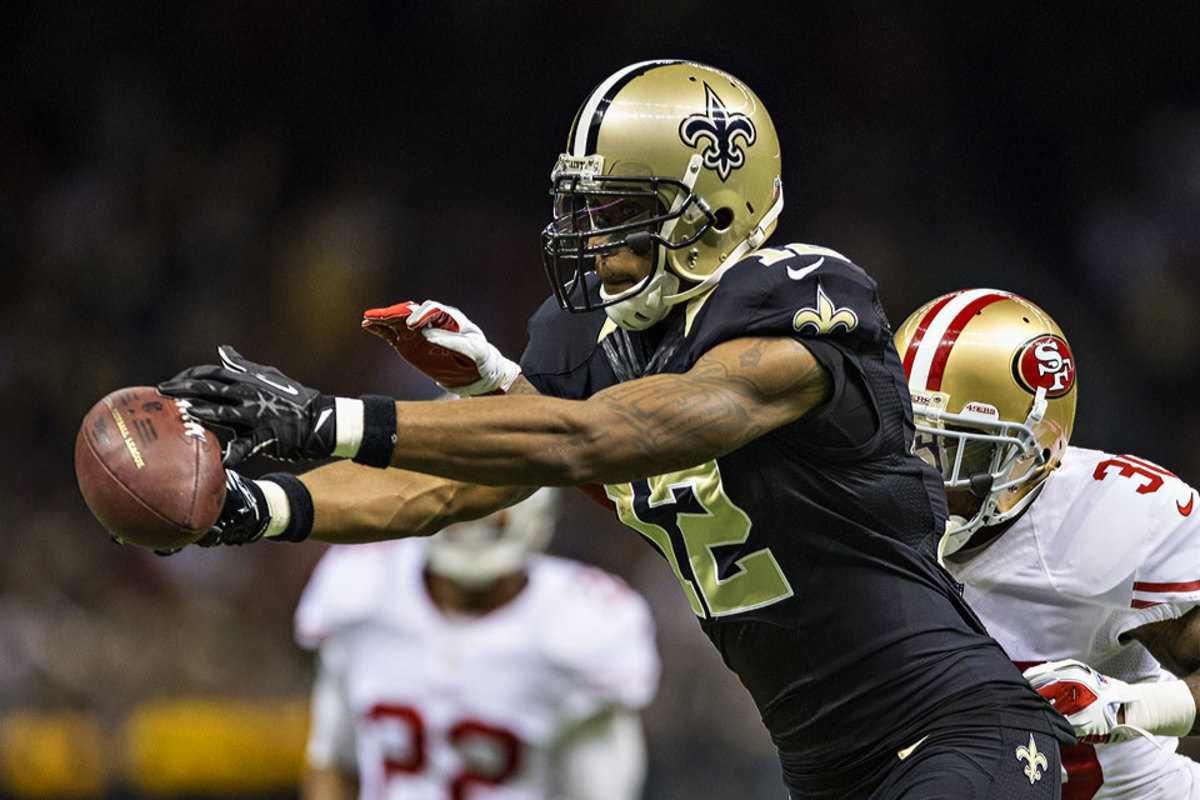
Marques Colston Is ‘One Good Player’
Marques Colston’s résumé is full of accolades and milestones, but the most crucial moment of his professional football life doesn’t appear anywhere in the media guide or the record book. After the Saints were thoroughly whipped by the Cowboys, 30-7, in a preseason game on Aug. 21, 2006, the unknown rookie received a compliment that catapulted his career.
The coach on the opposite sideline, Bill Parcells, liked the young wideout’s aggressive style on the field. And that was about the only thing that impressed him that night from New Orleans, which he made known to Sean Payton, his former protégé and the Saints’ new coach.
“You have one good player,” Parcells said, “and it’s Marques Colston.”
And with that, a seventh-round pick who was taken just three slots ahead of Mr. Irrelevant became a Week 1 starter. “It took Bill Parcells to do it,” says Curtis Johnson, who was then the Saints’ receivers coach and is now the head coach at Tulane. “And he’s been starting ever since.”
Not just starting, but setting the standard for Saints receivers. Colston has the most career catches (607), receiving yards (8,337) and touchdowns (63) in franchise history. He’s a six-time 1,000-yard receiver, and a Super Bowl champ who helped create a children’s book about being humble. He’s an integral part of an offense that will face the Seahawks’ top-ranked defense in the divisional round on Saturday, but his career continues in the same manner that it began: under the radar.
Colston is reserved off the field, but a menace for secondaries to contend with on back-shoulder fades and crossing patterns. (Tom DiPace/AP)
Now in his eighth NFL season, Colston prefers to sidestep the spotlight and goes to great lengths to do so. When he closed in on the franchise records for receiving yards and yards from scrimmage in November, he released a statement through the team’s public relations staff instead of holding court with the New Orleans press corps to talk about those benchmarks. In one recent, reluctant interview with The MMQB, his longest answer lasted just 15 seconds.
Colston’s business manager, Michael Harris, takes care to jokingly refer to himself as Colston’s “former” marketing agent, “because Marques doesn’t do marketing.” Colston consented to an off-field project this year, but only after Harris begged him for months to do it. He serves as an ambassador for Mercedes-Benz in New Orleans, but even that might not have happened if the luxury car company weren’t the name sponsor of the Superdome.
“He just doesn’t like his time to be used for photo shoots or appearances when it’s time he could use to make his game better, rehab himself, get himself stronger,” Harris says. “It would kind of disgust him, those athletes that did a lot of talking and not performing.”
Though he’s always been soft-spoken, that wasn’t exactly the Marques Colston who came out of Hofstra.
* * *
It’s hard to imagine any of Drew Brees’ 5,000-yard passing campaigns happening without Colston. But he was initially viewed as a practice squad player—assuming, that is, he could overcome the poor first impression he made during his rookie mini-camp.
“He was complaining about how tired he was, how his back was hurting him, how everything was going wrong,” Johnson says. “So I just had to tell Marques, ‘You drove down here in your—whatever he had, a 1972 Cadillac—and you will be going right back to Hofstra in that 1972 Cadillac if you don’t shape up.’ And I’m telling you, ever since he’s just been a wonderful player.”
Since then, he’s followed the same routine of staying after practice to get in at least 20 minutes of extra work with quarterback Drew Brees. They rehearse the specific throws and the moves they’ll need to make on game day, such as back-shoulder fades and routes on which Brees will lead Colston across the middle of the field.
Though he’s never earned a Pro Bowl nod, Colston has thrived in that area of the field where most receivers tend to shrink their arms. He ran 56.1% of his routes from the slot this season, according to Pro Football Focus, a tactic that makes him a versatile weapon against safeties, linebackers and back-up cornerbacks. The Saints share a similar offensive philosophy to New England’s, based around the art of creating mismatches, and though he may have average speed, Colston’s greatest advantage is his 6-4 frame that allows him to work the seam and box-out shorter defenders.
Though not the fastest of receivers, Colston’s 6-4 frame allows him to sky over smaller defenders. (Crystal LoGiudice/USA TODAY Sports)
“If he gets just a little bit of good position, Brees is going to put it on him,” says Patriots cornerback Aqib Talib, whose Bucs faced Colston twice a year during Talib’s four years in Tampa Bay. “He’s going to catch it.”
After playing through foot and knee injuries this season, Colston was given the Ed Block Courage Award by his teammates, another honor he is reluctant to discuss. And though his production dipped slightly this season, he still finished with 75 catches for 943 yards and five touchdowns. When the Saints visited Seattle in December, the Seahawks’ stingy secondary held Brees to 147 passing yards in New Orleans’ 34-7 loss. Colston had just four receptions for 27 yards in the blowout, but a week later caught nine passes (including two TDs) for a season-high 125 yards in a 31-13 victory over the Panthers. To change the outcome against Seattle in the divisional round, Colston and tight end Jimmy Graham must position their bodies in traffic to find the holes in coverage.
“Here’s the thing about when you’re going against a good secondary: It’s about impeccable timing,” Johnson says. “The timing of their throws, and the positioning where Marques and Jimmy will catch those balls, will be hard to cover.”
In most ways, Colston has always been difficult to lock down.
* * *
Colston is only 30, but he’s a football lifer. Back home in central Pennsylvania, he’s a majority owner of a professional indoor football team, the Harrisburg Stampede. Those around him say he hopes to continue working in professional sports when his playing career is over, perhaps in a personnel department or in a behind-the-scenes role. Though he won’t market himself, he became an owner of the Stampede to immerse himself in marketing, sales and operations as a transition plan to an inevitable second career.
Few ever thought he’d have a first one in the NFL, which begs an obvious question: Did the league misjudge him, or did he overachieve?
One former NFL personnel executive said his team received an unflattering report on Colston before the 2006 draft that was critical of his attitude and durability, and those insights came from some members of Hofstra’s staff. Published media reports before 2010, when former Hofstra head coach Joe Gardi passed away, suggest that Gardi and Colston had a strained relationship. The wideout’s position coach at Hofstra, Jaime Elizondo, says he told scouts about Colston’s physical toughness and good heart—and that he believed Colston would reward the team that took a chance on him, a chance the Saints took with the 252nd pick.
“His desire to be the best is a very quiet, internal thing,” Elizondo says of Colston.
But when Elizondo went to training camp with the Saints in 2007 as one of the league’s minority coaching fellows, he witnessed an unmistakable change in Colston. He was more mature, more detail-oriented, more driven. “He worked hard in college,” says Elizondo, now the offensive coordinator at Columbia. “But he said to me one time, ‘I didn’t work as hard as I absolutely could have.’ ”
Colston’s work ethic hasn’t been in question since his rookie mini-camp, though the man who once earned the nickname The Quiet Storm keeps his motivations to himself. He would prefer to skip media interviews and just make statements on the football field. “Eyes down, focusing on this week,” Colston told The MMQB after the Saints’ wild-card win over the Eagles. “It’s really just about going to work every day with a purpose.”
Even if he won’t expand upon that purpose, those who know Marques Colston beyond the field understand his motivation.
“His desire to be the best is a very quiet, internal thing,” Elizondo says, “not an outspoken, everybody-in-the-world-needs-to-see-me kind of thing.”
Yet it’s become impossible to miss.




































